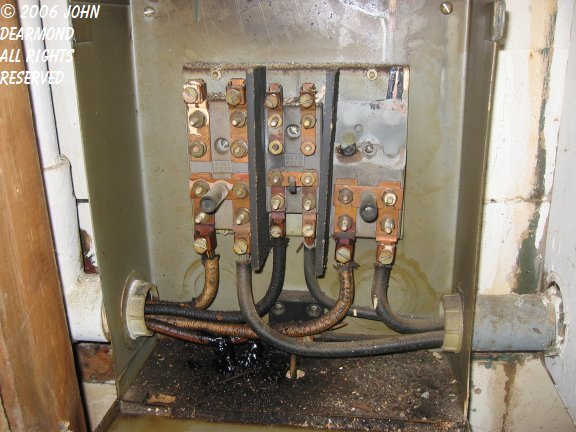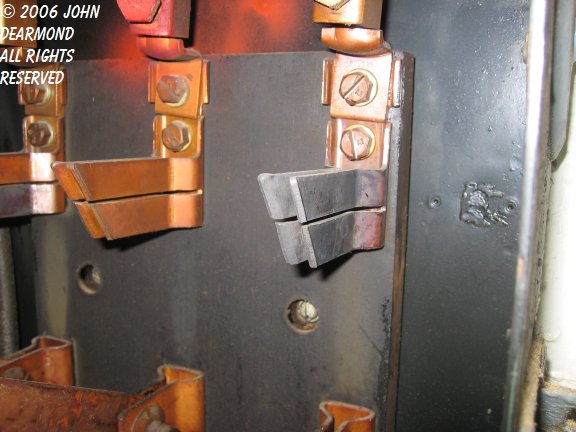Index
Home
About
Blog
From: John De Armond
Newsgroups: alt.energy.homepower,misc.rural,alt.home.repair
Subject: Re: What REC said: was "lost electricity"
Date: Thu, 24 Jan 2008 22:40:37 -0500
Message-ID: <pplip3p27j6q3eojv5m3e9gevp5efc1gdu@4ax.com>
On Thu, 24 Jan 2008 17:19:01 -0900, floyd@apaflo.com (Floyd L. Davidson) wrote:
>"Stormin Mormon" <cayoung61**spamblock##@hotmail.com> wrote:
>>He's not talking resistance -- he's talking about a short circuit. Please be
>>sure of your terms before you call someone else names, and insult them.
>>
>>I've known of houses with broken down insulation in the lead in wire,
>>creating a high energy bill. So, it's a real condition.
>
>More total bullshit. That would burn the house down
>long before you got the bill. As Mike said, if the
>connection where so hot it was shining brightly in the
>daylight... and indeed that is what it would take to
>create a high energy bill, and it *would* set fire to
>something.
Really? Then according to your expert theory, my restaurant ought to have burned
down long ago.

That photo is of what is left of the original 40s vintage 3 phase indoor meter box.
Long since bypassed as a meter base, it still passed up to 300 amps at times. That's
either #4 or #2 cloth covered, rubber insulated wire in the service entrance. #4, I
think. It's obviously been hot enough to slag the rubber insulation but somehow it
just keeps on truckin'. Of course, the wire is in rigid conduit and despite your
declaration to the contrary, steel still doesn't burn very well.
That conduit has been too hot to touch on occasion. I monitored it closely in the
summer time. I'd have loved to have replaced it but the city says that I can't do my
own electrical work and I'm not about to pay someone else to do it so... It's been
there since the 40s and it'll probably be there until the building is torn down.
Perhaps you ought to look at the other post I made in this thread about how to
compute irradiative losses from a hot object. The concept is simple enough for
someone even of your caliber to understand.
Maybe you ought to get your code book out too. At various places it discusses the
losses involved in various wire and cable temperature rises.
John
From: John De Armond
Newsgroups: alt.energy.homepower,misc.rural,alt.home.repair
Subject: Re: What REC said: was "lost electricity"
Date: Fri, 25 Jan 2008 01:28:09 -0500
Message-ID: <cttip3lb2jnh3drjjkmj6du22mvcvnkhe0@4ax.com>
On Thu, 24 Jan 2008 18:54:22 -0900, floyd@apaflo.com (Floyd L. Davidson) wrote:
>Neon John <no@never.com> wrote:
>
>>Really? Then according to your expert theory, my restaurant ought to have burned
>>down long ago.
>
>>

>
>Sure sonny. Now tell us just how much electricity that
>mess actually used. Nothing there used up enough power
>to cost more than 20 cents a month!
My, such charm and wit.
OK, well "Pop", let's go back to that Stefan-Boltzmann calculator and do a little
math.
The conduit between the meter base and that box is about 40 ft of 2" rigid conduit.
It runs exposed so we don't need to worry about conduction losses, only radiative and
convective.
Forty feet of 2" conduit is 21 sq ft. Let's use 80 deg C for the conduit because
that is just about "too hot to touch" and 20 deg ambient. We'll use 0.95 emissivity
since the conduit is old and dirty and pretty close to a black body. That comes out
to 858 watts. In that temperature range, convective losses will be about twice those
of radiative losses so we'll figure 1716 watts there for a total of 2,574 watts.
My restaurant was open about 70 hours a week and the load remained fairly constant
throughout the day so 2,574watts * 70hours * 4weeks = 721kWh. At $0.09 per kWh,
that's $64.89 per month. A bit more than 20 cents a month, wouldn't you say? Chop
the calculated amount in half or even by 10 if you like. Doesn't matter, you're still
wrong by an order of magnitude.
And I didn't even try to account for the cost of air conditioning that heat to the
outside, a necessary task since all but a couple of feet of the conduit runs in air
conditioned spaces.
Sanity check: Using the 0.000292 ohms per foot from
http://www.epanorama.net/documents/wiring/wire_resistance.html for #4 wire and 120
feet of wire (three phase) and 300 amps, that works out to 3,154 watts. At 250 amps,
2,190 watts. That brackets my calculated values nicely. Sanity check passes.
Feel free to plug your own numbers and see what you get. It'll be > 20 cents.
You remind me of that old saying: "Those who ignore the math are doomed to look like
idiots."
John
From: John De Armond
Newsgroups: alt.energy.homepower,misc.rural,alt.home.repair
Subject: Re: What REC said: was "lost electricity"
Date: Fri, 25 Jan 2008 19:47:37 -0500
Message-ID: <oltkp3lj7oinkr943moh79k5c5q6jt14uf@4ax.com>
On Fri, 25 Jan 2008 09:35:40 -0900, floyd@apaflo.com (Floyd L. Davidson) wrote:
>Neon John <no@never.com> wrote:
>
>>The conduit between the meter base and that box is about 40 ft of 2" rigid conduit.
>
>Learn to read and respond to the topic of discussion.
>
>You are talking about a 40 foot run of cable. Nobody
>else is.
Actually YOU were, when you asked me how much electricity "that mess actually used".
That mess was the end of that 40 ft run of conduit. Whatever, I can do calculations
on most anything.
>
>The discussion was about what happens with a single
>connection inside that junciton box. If it is a high
>resistance sufficient to cause even a slight reduction
>in the power available to other loads on the circuit, it
>is going to get hot and either burn through and become
>an open, or start a fire.
Sorry, Pop, you lose again. Actually the thread started out about a hot conduit and
morphed into your "hot contact flambe'" theory. Whatever, let's do a contact.
How 'bout this one?

That contact is about 1.5" tall average, and about an inch wide. The surface area of
one side is therefore 1.5 sq inches. For both sides, 3 sq inches. Let's add another
square inch to account for the mating blade that isn't visible in the photo, for a
total of 4 sq inches or 0.333 sq ft.
I've measured that blade tip at over 600 deg with a infrared pyrometer. Since the
heating is uneven, especially along the blade, let's use 450 deg as an average
temperature. And since the box gets hot, let's use 30 deg as the ambient. This is
conservative since when I made the measurements I had to have the door open and that
exposed most of the contact to 20 deg ambient. We'll stay conservative. The
emissivity of oxidized copper is 0.98 according to my table. We now have enough to
compute the radiated energy.
Remember this page?
http://hyperphysics.phy-astr.gsu.edu/Hbase/thermo/stefan.html#c3
Plugging all that in, the result is 96.5 watts. Again assuming twice the convective
losses or 193 watts, the total comes out to 289 watts.
That seems reasonable, as in the heat of summer I've had to open the box and place a
fan on it to keep conducted heat from blowing the fuse. It also seems reasonable for
how hot a metal box that size would get with a 300 watt heater inside.
Cost
Let's use the same assumptions from my last post. 80 hours a week, 4 weeks in the
month or 320 hours in the month. 0.289kW * 320 hours is 93kWh. At 9 cents a kWh,
that's $8.34 for the month. Which is, last time I looked, > 20 cents a month.
So. Again, feel free to plug in any numbers that you like; I've held your hand and
led you through the methodology. While you're cogitating, keep in mind that I took
no credit for losses through the bulk of the blade, the hinge or the fuse and holder.
Since enough heat conducts down the blade to contribute to the fuse's melting below
its amp rating, that amount of heat is non-trivial.
Regardless of any assumptions you might choose, this one hot connection certainly
used more than your "20 cents a month" claim. Strike 2.
Nor does your claim withstand scrutiny that a hot connection that is dissipating
significant power will burn up. Strike 3. You're outta here.
Such a hot joint IS a risk but not of fire at this power level. The only real risk
is of an outage if the thing finally oxidizes sufficiently that it doesn't make
contact anymore or that it arcs and melts. No fire possible inside that metal
switchgear.
The risk of outage and in larger gear, fire or explosion AND the operating cost of
the joint is why companies hire people like me to do energy audits and thermal scans.
The main driving force with every client I've ever had was cost - cost of an outage
and cost of operating that hot joint.
>
>You've compared grapefruit and oranges, but we were
>talking about apples.
So now we talk about apples, only for you to demonstrate that you don't know them
either. Every time you open your yap you dig your ignorance hole a bit deeper. Why
don't you give it a rest before you bury yourself (deeper) in stupidity.
John
From: John De Armond
Newsgroups: alt.energy.homepower,misc.rural,alt.home.repair
Subject: Re: What REC said: was "lost electricity"
Date: Fri, 25 Jan 2008 19:54:29 -0500
Message-ID: <7t0lp3t0q3v7j71o2c4ukd5p2fbo5ifgf5@4ax.com>
On Fri, 25 Jan 2008 09:30:41 -0500, "Stormin Mormon"
<cayoung61**spamblock##@hotmail.com> wrote:
>The one time I saw this, the electrician pulled the lead in wire, that had
>been from the meter to the panel box. He set the wire on the ground, and
>used his Simpson VOM to read from hot to hot -- there was less than
>infinity resistance. I didn't see on his meter how many tens or hundreds of
>K-ohms, but there would have been current flow, with 220 VAC applied.
That wouldn't be unusual if the wire were wet, for example. PVC insulated wire that
has overheated breaks down and one of the breakdown products is hygroscopic. Thus,
moisture in the conduit would not be unusual.
That resistance wouldn't be dissipating any significant power, however. Consider
10kohms and 240 volts. (10kohms would be a very low resistance for such a
circumstance so consider it an extreme example) P = Vsquared/R or about 6 watts. The
bulk of the heating was simple I^2R losses from the current passing through the
conductors and perhaps some conducted heat from the hot joint.
John
Index
Home
About
Blog


